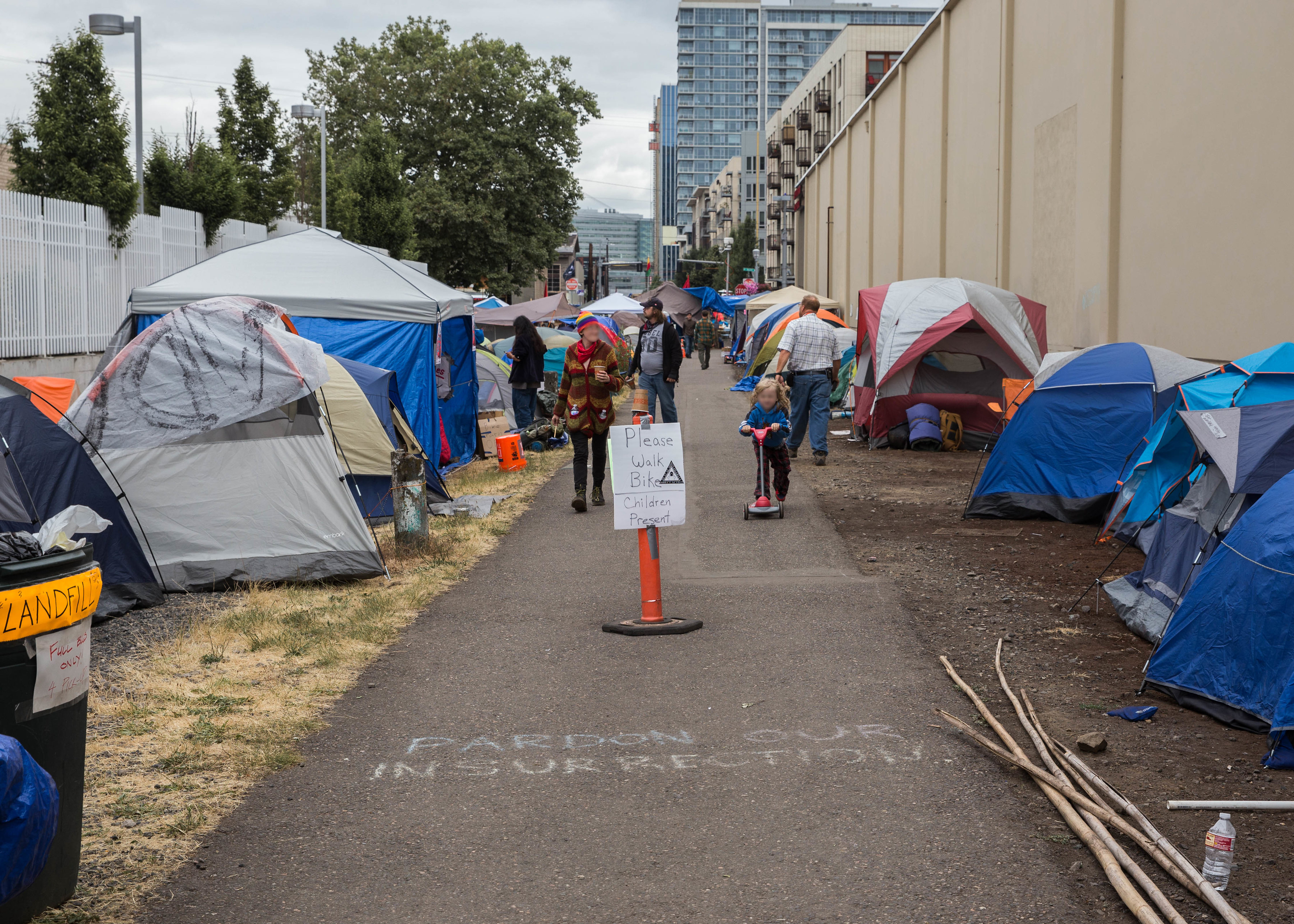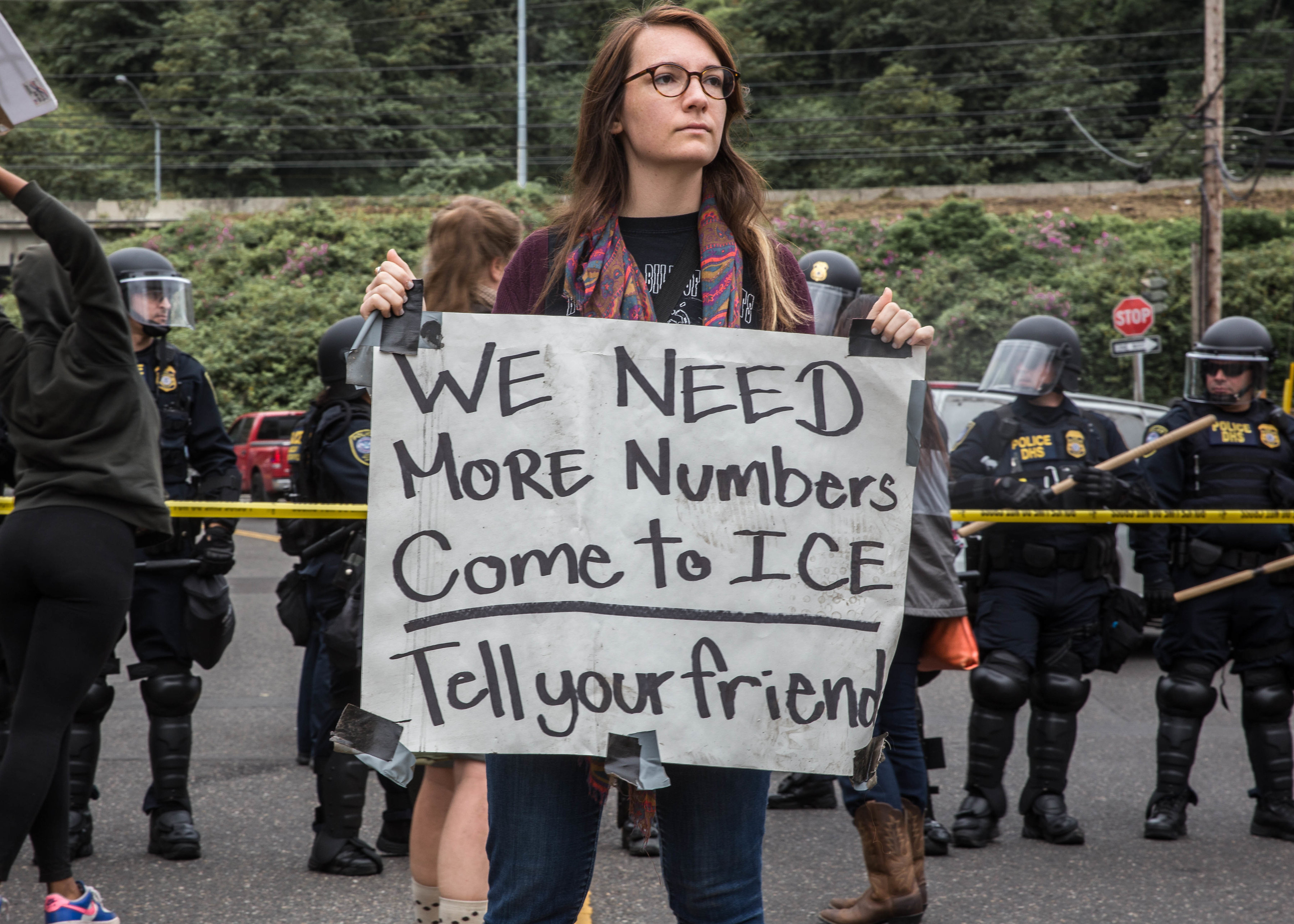Inside the Portland Occupy ICE Camp and Its Battle with the Feds
Around 5:30 AM Thursday morning, the Department of Homeland Security finally staged the raid the #OccupyICEPDX encampment had known would be coming since the protesters shut down the ICE facility in Portland, Oregon, last week. DHS officers, adorned in full riot gear and brandishing automatic weapons and shields, announced a final warning to clear the entrance over a loudspeaker as they moved in, rousing sleeping occupiers and pulling down tents. By sunrise, a handful of protesters had been cuffed (seven got misdemeanor charges for failing to comply with federal officers’ orders) and the entrance to the ICE building, which had been closed since June 20 due to the protest, was protected by a line of federal officers. The office was opened and remains open, despite the contentious standoff between the feds and protesters—separated only by police tape—which was still ongoing as of Friday afternoon.
Knowing that the DHS’s jurisdiction ends at the property line of the ICE building, the occupiers had built the majority of their camp in the adjacent alley, land owned by the city of Portland (the mayor has said city cops won’t interfere with the protest as long as it remains peaceful). Because of this, the vast majority of the encampment remained undisturbed. What began as a vigil for families being separated by the Trump administration’s zero-tolerance immigration policy attended by a handful of people on June 17 has now blossomed into a camp of 100-plus tents fortified by hundreds of pallets and impressive, if makeshift, carpentry.
Entering the encampment, one is greeted by cooking smells and the sounds of power tools and hammers as occupiers work to build ramps for those in wheelchairs. Volunteers from the kitchen whiz by as they bring hot breakfasts to those on the front line (Thursday’s consisted of pancakes, scrambled eggs, and bacon). All of this is being observed by federal agents from the roof of the ICE building, so the occupiers have covered much of the camp in tarps.

It would be a mistake to assume those in this burgeoning occupy movement are mindless anarchists hellbent on nothing but destruction. There is an element of that, sure, but the group’s incredibly diverse leadership, which consists almost entirely of people of color and members of the LGBTQ community, is running the protest with near-military precision. Shifts are discussed and divvied up so that people can rest, run home for supplies, or make it to work. Several occupiers told me their employers are sympathetic to the cause and are allowing them to miss time without fear of reprisal.
Once the initial shock of morning’s raid wore off, the protesters wasted no time regrouping. “We all knew this was coming, so we’re not intimidated in the slightest, our tactics have just evolved. I hope they’re ready to wait us out because we’re not going anywhere,” a protest leader who wished to remain anonymous told me. She added that feds in plainclothes came into the camp in the alley under the cover of the confusion caused by the raid and took multiple phones from the charger station—this despite the fact that federal jurisdiction ended at the ICE property line. The occupiers’ lawyers, including attorneys with the National Lawyers’ Guild, have claimed the agents had no right to take possessions not on ICE property.
Time and again those I spoke with reiterated that people can help in any number of ways besides showing up in person. Outside aid has been essential to the occupation’s continued existence. In addition to the lawyers volunteering their time, supplies varying from generators to port-a-potties to food are consistently being donated. Pizzas, coffee, and subs showed up throughout Thursday, and at one point a Caviar delivery guy rolled up on his bike in the midst of the madness and, taken aback by various calamities surrounding him, paused to take in the surreal scene.
Perhaps the most impressive display on Thursday was that of the senior citizen protesters, most of whom were women. At one point I turned around to see a gray-haired woman waving an antifa flag atop a 15-foot flagpole, a giant grin affixed to her face. There was a group of elderly ladies sitting in lawn chairs less than a foot from the police tape and the heavily armored feds behind it. One of the ladies was knitting. “We did this same thing back in ‘68!” I overheard one of the women gleefully tell a fellow protester young enough to be her grandson.
It’s difficult to overstate the animus being expressed toward the federal law enforcement present. Most of the officers remained dispassionate in the face of satirical jabs and hateful language, but there were a few exceptions. At one point on Thursday, one of the protest leaders’ teenage daughter asked a white cop if he cared about the kids in cages. He said no. She then asked if he was “ready to shoot us,” to which the fed smiled and replied in the affirmative. (I confirmed this exchange with multiple sources.)
The most heated exchanges came between the protesters of color and the feds who were also minorities. “How can you do this to our babies? Don’t you care about our people?” was the passionately repeated query of a tearful woman of Latin descent to a fellow woman of color in riot gear. “If this was 50 years ago, what side of the line would you be on?” another demanded of young African American federal officer, whose mask of stoicism slipped ever so briefly at the barb.

The day’s most impassioned speech came from an undocumented woman who told the crowd she was there despite the very serious risks to her freedom because what was happening was a matter of life and death for her community. After she concluded her speech by leading the group in a chant and marching directly up to the gathered federal cops, I asked her how she could risk so much so openly. “I came out of the shadows to try and inspire people,” she told me. “Especially our white friends. Think about it: If this group was a bunch of only brown and black people gathering here, we’d be attacked by the cops immediately. They (white people) can help simply by being here and using their privilege for good. I hope that good people in other cities who think this is wrong can look to Portland as an example and start their own movements.”
The camp remains a bizarre scene, and the source of many unexpected moments. After days of being shut down by the occupation, the walls of the ICE office and the surrounding sidewalks had become covered in chalk graffiti denigrating the agency, so the feds called in a pressure washing crew to clean up the site. The crew that showed up Thursday afternoon looked more than a little bewildered as they were greeted with a chorus of jeers from the occupiers, who wondered aloud if the crew knew who they were working for. A fast-thinking protester in a wheelchair decided to call the company hired to do the power washing, River City Environmental, and in their “best polite white lady voice,” told the business why the cleaners had been hired and by whom. The company responded by calling their workers off the job, only to have them return to the site a couple of hours later—except this time they showed up on the other side of the police line with pizza and water for the protesters, who greeted them with a hero’s welcome. Solidarity, as one protester exclaimed, comes in many forms.
Sign up for our newsletter to get the best of VICE delivered to your inbox daily.
Follow Donovan Farley on Twitter.
This article originally appeared on VICE US.